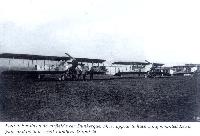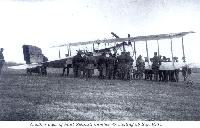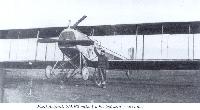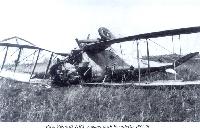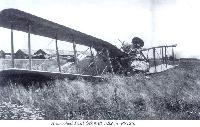В.Кондратьев Самолеты первой мировой войны
ШМИТТ 7B / SCHMITT 7B
Крупногабаритный четырехстоечный биплан цельнодеревянной конструкции с полотняной обшивкой. Разработан французским авиаконструктором, энтузиастом тяжелых грузоподъемных аэропланов Полем Шмиттом на базе довоенного многоместного самолета "Аэробус" (Aerobus), совершившего в 1913 году рекордный полет с девятью пассажирами на борту.
Проектирование машины начато в ноябре 1915 года в связи с объявленным Директоратом аэронавтики конкурсом на мощный бомбардировочный аэроплан. Однако по целому ряду причин, как производственного, так и частного характера, разработка проекта и постройка прототипа шли очень медленно. Только в феврале 1917 года первый экземпляр бомбардировщика поднялся в воздух. Результаты испытаний не внушали оптимизма. Самолет получился явно переразмеренным и сильно перетяжеленным. Мощности 200-сильного мотора не хватало для полета с полной нагрузкой.
И все же небольшая серия "Шмиттов" была построена ив апреле-мае поступила на вооружение четырех французских эскадрилий на западном фронте. Некоторые машины оснащались двумя дополнительными противокапотажными колесами перед основной тележкой шасси. Эта модификация получила обозначение "Шмитт 7/4".
Вскоре выяснилось, что для обеспечения более-менее приемлемых летных данных бомбовая нагрузка не должна превышать 200 фунтов (примерно 90 кг) - смехотворно мало для столь крупной машины. Кроме того, медлительный и неповоротливый аэроплан оказался удобной мишенью для вражеских зениток и истребителей. В результате, уже к июню 1917-го завод Шмитта прекратил выпуск бомбардировщика, а в январе следующего года "Шмитт 7В" был окончательно снят с вооружения. Одна машина летом 1917 года проходила испытания в России, но на вооружение самолет принят не был.
ДВИГАТЕЛЬ
"Рено", 200 л.с.
ВООРУЖЕНИЕ
1 турельный "Льюис" и 150 (фактически не более 90) кг бомб.
ЛЕТНО-ТЕХНИЧЕСКИЕ ХАРАКТЕРИСТИКИ
Шмитт S.7 B2
Размах, м 17,65
Длина, м 9,60
Высота, м 3,58
Площадь крыла, кв.м 72,00
Сухой вес, кг 1294
Взлетный вес, кг 2092
Двигатель: "Рено"
мощность, л. с. 265
Скорость максимальная, км/ч 135
Время набора высоты, м/мин 2000/21
Потолок, м 4270
Экипаж, чел. 2
Вооружение 2-3 пулемета
152 кг бомб
Показать полностью
А.Шепс Самолеты Первой мировой войны. Страны Антанты
Шмитт S.7 В2 1915 г.
После успешного дебюта на Парижском аэросалоне в 1913 году самолета "Аэробус" и ряда рекордных полетов в 1914-м, Поль Шмитт предложил военному ведомству сделать одномоторный Шмитт предложил военному ведомству сделать одномоторный разведчик и легкий бомбардировщик. Используя опыт создания "Аэробуса" и установив мощный рядный двигатель жидкостного охлаждения "Рено" (265 л. с.), во второй половине 1915 года Шмитт поднял в воздух новый самолет S.7 B2. Это был трехстоечный биплан деревянной конструкции. Двигатель устанавливался на металлической раме, а перед ним крепился лобовой радиатор. Панели капота двигателя изготавливались из жести. Выхлопной коллектор выводился над верхним крылом. Средняя и задняя часть фюзеляжа облицовывалась полотном с пропиткой аэролаком. Для обеспечения необходимого обзора пилот и стрелок размещались за задней кромкой крыла. Между двигателем и пилотом устанавливались топливный и масляный баки. Крыло двухлонжеронное, деревянной конструкции, обтягивалось полотном и оборудовалось элеронами (только на верхнем крыле). В местах пересечения растяжек между главными стойками устанавливались дополнительные стойки для обеспечения жесткости конструкции.
Горизонтальное оперение не имело стабилизатора и, как бескилевое вертикальное оперение, было деревянным и обтягивалось полотном. Управление тросовое, от штурвала и педалей. За костылем под фюзеляжем имелась дополнительная рулевая поверхность. Шасси имели каркас из стальных труб, колеса крепились к жесткой горизонтальной оси. Вооружение состояло из синхронного пулемета 7,69-мм "Льюис" и такого же пулемета на турельной установке у стрелка-наблюдателя. Под крылом подвешивалось более 150 кг бомб. В конце 1916 года машины начали выпускаться серийно и поступать в эскадрильи французских ВВС. В начале 1917 года, после обучения, эскадрильи PS.125, PS.126 и PS.127 начали боевые вылеты.
На некоторых машинах на турели устанавливалась спарка пулеметов "Льюис". Машины последних серий имели шасси с четырьмя колесами для предохранения винта при посадке. Машина обозначалась S.7/4 B2. Ими была вооружена эскадрилья PS.128. Однако большого распространения машина не получила. Созданная по требованиям 1915 года, к 1917 году она уже устарела. Большой размах крыльев, обеспечивающий большой радиус действия, снижал маневренность машины и ограничивал сектор обстрела стрелка. Появление же более скоростных и маневренных машин "Сопвич-полуторастоечный" и Bre.14 B2 привело к тому, что S.7 B2 были к концу 1917 года переданы в учебные подразделения. Всего было выпущено более 200 машин этого типа.
Показать полностью
J.Davilla, A.Soltan French Aircraft of the First World War (Flying Machines)
Paul Schmitt 7
The Paul Schmitt 7 was a development of the Type 6 bomber. In most respects it was identical to the Type 6 and both used the 250-hp Renault engine. However, the lower wing of the Type 7 was attached directly to the fuselage. Thus the Type 7 carried the Schmitt designation B.R.A.H., standing for Bomber Renault Aile Haute (high wing). The wing area was so large that it led to serious problems when the Type 7 was introduced into operational service. As with the Type 6, the Type 7 dispensed with the variable incidence wing. The wings were constructed in two parts mounted to a fixed central section. The center section was attached to the fuselage by four steel tubes. The fuselage was constructed entirely of metal and covered with aluminum. As with the Type 6, the radiator was located in the nose. The landing gear was altered on the Type 7; whereas the Type 6 had featured a quadracycle undercarriage or nose skids, most Type 7s had a single pair of wheels beneath the fuselage. The landing gear was supported by ash runners and bungee cords which served as shock absorbers. Wing spars were made of ash and pine. The wing formers were of plywood. There were 16 struts; four were of metal, the others of pine. Ailerons were on the top wing only. There was a fuel tank of of 450 liters capacity.
The B.R.A.H. was given the STAe designation Paul Schmitt Type 7, and approximately 150 were ordered. They are believed to have had Schmitt construction numbers 33 to 180 and carried military serials P S 22 to P S 170.
The Paul Schmitt 7/4 was the only major variant of the P.S.7. It featured dual nosewheels, presumably added to prevent the aircraft from nosing over during landing. This was a common problem with French night bombers of the period; the heavily laden aircraft frequently crashed when they attempted night landings on soft or muddy soil. The addition of the nosewheels would have become necessary when the role of the Paul Schmitt 7 was changed from day to night bomber.
The government contract for the P.S.7 was to prove a mixed blessing for Schmitt. While he now had the opportunity to produce a new bomber for the Aviation Militaire, he had yet to create a factory to produce the planes. Like many other French aviation pioneers, Schmitt had very limited financial and manufacturing resources. He was able to secure economic assistance from diverse sources, including a French minister of parliament and an American banker who anticipated selling large numbers of P.S.7s to the fledgling American air service.
However, Schmitt's problems were far from over - he still needed to construct a factory to assemble the bombers. Huge sums of money were spent building the Schmitt establishment, obtaining the requisite raw materials, and hiring a skilled work force. The result was that the Schmitt bomber, which had been selected as an interim day bomber in 1915, did not reach frontline units until April 1917. By 1 August 1917 only 16 were in service. The delay was to prove fatal both for Schmitt's plans to produce an armada of P.S.7s and for the unfortunate crews who had to fly the obsolete machines in combat.
Operational Service
On 8 April 1917 PS 125 and PS 126 were formed on the Paul Schmitt 6 and 7. Two additional units were formed, PS 127 on 14 April and PS 128 on 15 May 1917. All four were assigned to GB 3 on 7 July 1917.
It was soon apparent that the new bomber had serious deficiencies. The aircraft were found to be too slow and carried inadequate protection for daylight missions (this problem had been noted as far back as the 1915 concours puissant). The flying characteristics of the P.S.7 were so poor that the aircraft became unstable if the maximum bomb load was carried. The bomb load had to be reduced even further so that more defensive armament could be carried, the aircraft being particularly vulnerable to fighters because of its slow speed. Formation flying was virtually impossible because of the P.S.7's poor maneuverability, due to the huge wing. The aircraft, because they were unable to fly in light formation, could not concentrate their firepower and were therefore easy prey for German fighters.
The PS escadrilles of GB 3 were based at Plessier Saint-Just in April, operating a mix of P.S.6s, P.S.7s, and P.S.7/4s. After the PS escadrilles had been attached to GB 3, the group moved to Pierrefonds. From this base the PS units were to bomb targets in the Somme and Aisne sectors. Later in the month the Paul Schmitt bombers were active over the Serre Valley. On 2 May the PS units successfully bombed Essigny-le-Petit. On 27 May a major raid was flown on the Nouvion-Catillon aerodrome. The next month the units spent most of their time practicing formation flying. They returned to action on 13 July when stations and bivouacs were attacked. Eleven days later, the 18 aircraft bombed German camps at Lanquetaille, and two machines of PS 125 bombed the Cambrai train station. An attempt to bomb targets in the vicinity of Pouilly sur Serre proved disastrous; enemy fighters caused heavy casualties and forced the escadrilles to miss the target. The PS units were then assigned to support the G.A.N. during the Second Battle of the Somme and l'Aisne. Various train stations along the front were attacked in September. October would be the last month the PS 7s would be used operationally, when Catele, Ramicourt, and the cement plant at Mont d'Origny were attacked. It was now obvious that the Paul Schmitt 7s were useless in either the day or night bombing role. PS 128 received Sopwith 1 1/2 Strutters in June. PS 126 and PS 127 re-equipped with Breguet 14 B2s in November and PS 125 received Voisin 8s on 24 January.
Production delays had resulted in an aircraft that incorporated the technology of 1915 being introduced into combat in 1917. Given the rapid pace of aviation development in the intervening years, it is not surprising that the Paul Schmitt 7s proved to be a costly failure.
Paul Schmitt 7 Two-Seat Bomber with 250-hp Renault
Span 17.50 m; length 9.50 m; wing area 48.40 m
Empty weight 1,298 kg; loaded weight 2,098 kg
Maximum speed: 135 km/h at 2,000 m; 131 km/h at 3,000 m; 121 km/h at 4,000 m; climb to 2,000 m in 21.45 minutes; climb to 3,000 m in 36.5 minutes; ceiling approximately 4,000 m; endurance 5 hours
Armament: two 7.7-mm machine guns fired by the gunner and 150 kg of bombs
Approximately 150 built�
Показать полностью







